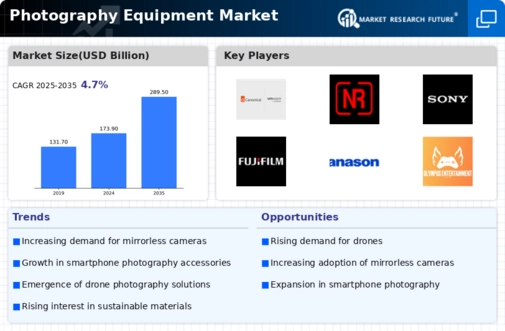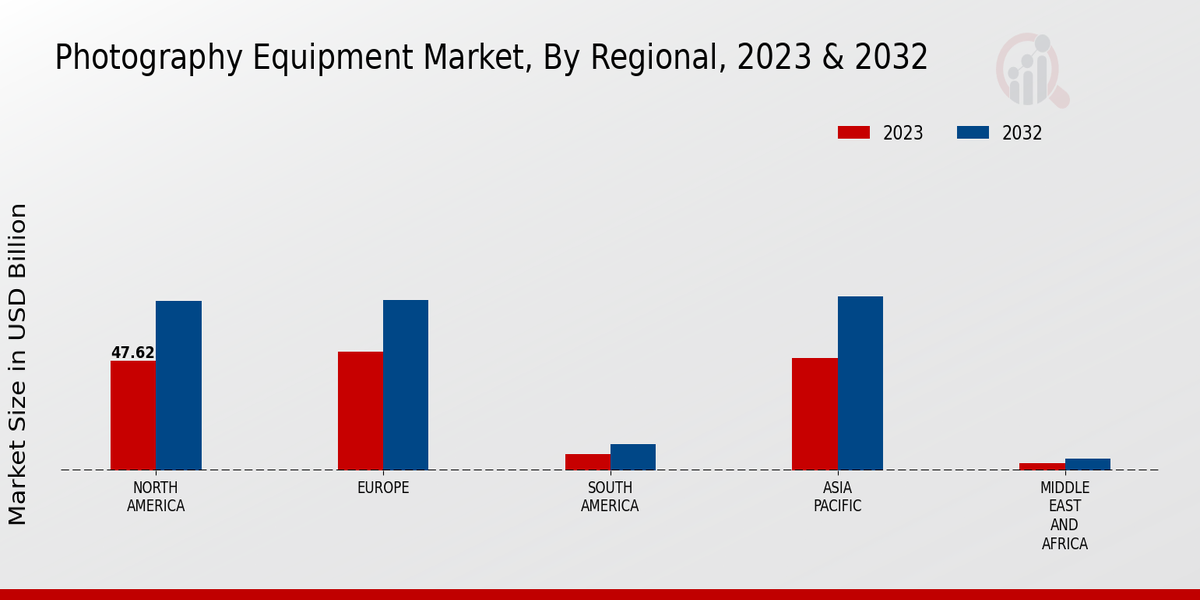Market Growth Projections
The Global Photography Equipment Market Industry is poised for substantial growth, with projections indicating a market value of 173.9 USD Billion in 2024 and an anticipated increase to 289.5 USD Billion by 2035. This growth trajectory suggests a robust demand for photography equipment driven by various factors, including technological advancements, rising consumer interest, and increased investment in professional photography. The compound annual growth rate (CAGR) of 4.74% from 2025 to 2035 further underscores the industry's potential for expansion. This upward trend reflects the evolving landscape of photography and the continuous innovation within the Global Photography Equipment Market Industry.
Rising Demand for High-Quality Imaging
The Global Photography Equipment Market Industry experiences a notable surge in demand for high-quality imaging solutions. As consumers increasingly seek professional-grade photography for personal and commercial use, manufacturers respond by innovating advanced camera technologies. This trend is evidenced by the projected market value of 173.9 USD Billion in 2024, driven by the popularity of mirrorless cameras and high-resolution sensors. Additionally, the rise of social media platforms amplifies the need for superior image quality, compelling both amateur and professional photographers to invest in premium equipment. Consequently, this demand for enhanced imaging capabilities significantly propels growth within the Global Photography Equipment Market Industry.
Technological Advancements in Photography
Technological advancements play a pivotal role in shaping the Global Photography Equipment Market Industry. Innovations such as artificial intelligence, machine learning, and enhanced connectivity features are revolutionizing the photography landscape. For instance, the integration of AI in camera systems allows for improved autofocus and image processing, enhancing user experience. Furthermore, the advent of smartphone photography with advanced camera capabilities has led to a shift in consumer preferences, prompting traditional camera manufacturers to adapt. This ongoing technological evolution is expected to contribute to the market's expansion, with a projected CAGR of 4.74% from 2025 to 2035, reflecting the industry's responsiveness to emerging trends.
Emerging Markets and Consumer Accessibility
Emerging markets present a significant opportunity for the Global Photography Equipment Market Industry. As disposable incomes rise in developing regions, consumers are increasingly able to invest in photography equipment. This trend is particularly evident in countries such as India and Brazil, where a growing middle class is driving demand for affordable yet high-quality cameras. Additionally, the proliferation of online retail platforms enhances accessibility, allowing consumers to purchase photography equipment with ease. This shift towards consumer accessibility is likely to contribute to the market's growth, with projections indicating a CAGR of 4.74% from 2025 to 2035, reflecting the potential of emerging markets within the Global Photography Equipment Market Industry.
Growth of Content Creation and Social Media
The proliferation of content creation and social media platforms significantly influences the Global Photography Equipment Market Industry. As individuals and businesses increasingly rely on visual content for marketing and engagement, the demand for high-quality photography equipment escalates. This trend is particularly evident among influencers and content creators who prioritize professional-grade cameras and accessories to enhance their visual storytelling. The market's projected growth to 289.5 USD Billion by 2035 underscores the importance of this driver. Moreover, the rise of video content further fuels the demand for versatile equipment, prompting manufacturers to innovate and cater to the evolving needs of content creators within the Global Photography Equipment Market Industry.
Increased Investment in Professional Photography
The Global Photography Equipment Market Industry benefits from a surge in investment in professional photography services. Businesses across various sectors recognize the value of high-quality imagery in branding and marketing efforts, leading to increased spending on photography equipment. This trend is particularly pronounced in industries such as real estate, fashion, and advertising, where visual representation is crucial. As a result, the demand for professional-grade cameras, lenses, and lighting equipment continues to rise. The anticipated growth of the market to 289.5 USD Billion by 2035 reflects the ongoing commitment of businesses to enhance their visual content, thereby driving the expansion of the Global Photography Equipment Market Industry.






















Leave a Comment